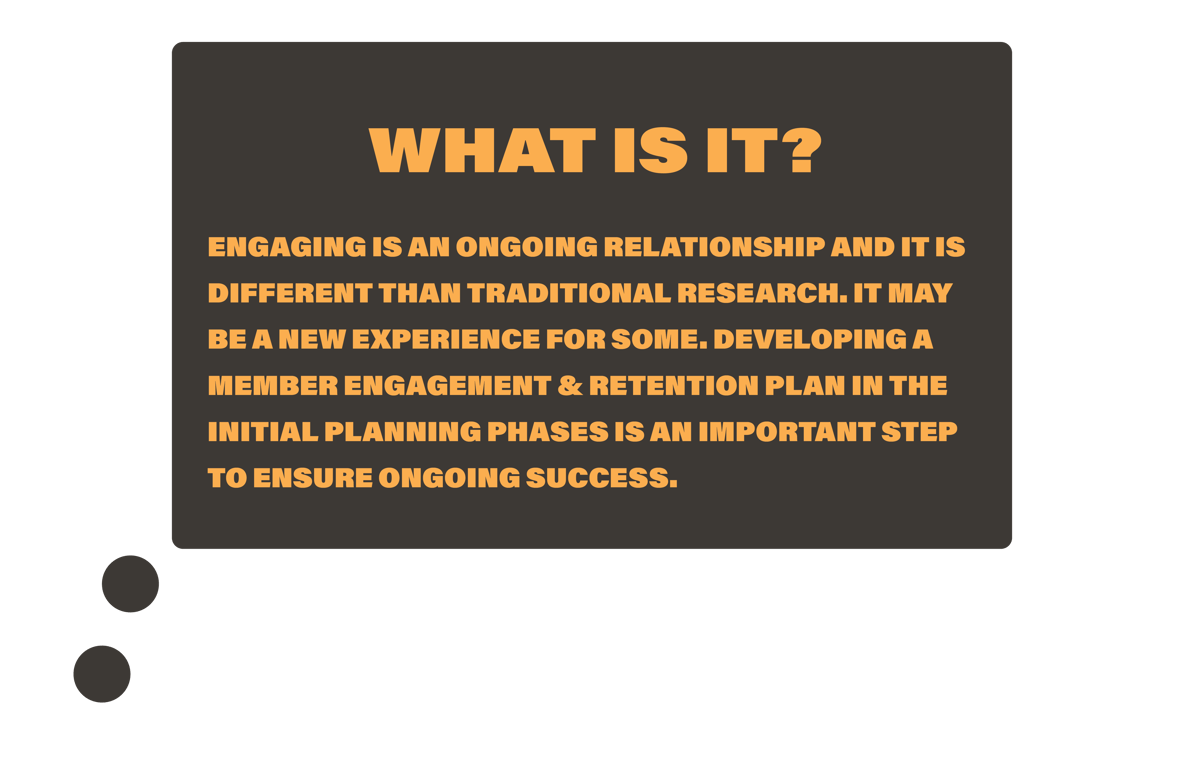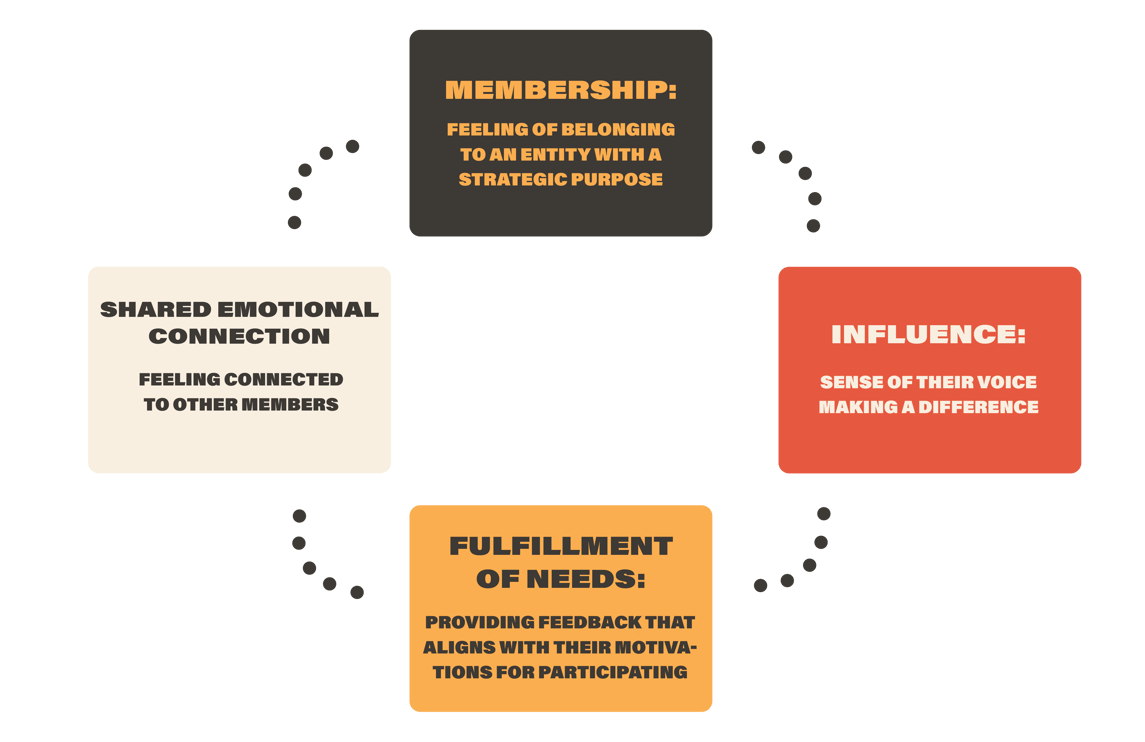When building an ongoing community management plan, consider what kind of relationship your brand wants to have with your customers, and what kinds of things will be interesting, relevant and fun for them.

Based on our “research on research” members who achieve a sense of community have the highest level of value and satisfaction. We define sense of community by looking at 4 factors:

Your plan should include elements that will appeal to members and keep them interested in participating:
- Short, relevant activities that are mobile-optimized
- Activities based on topics of interest (in addition to research needs)
- Regular sharebacks to inform members on how their input has been used and valued, and other updates about the Community
- Note: Avoid sharing back information about your company that members could find on your social media sites or website; the community sharebacks should be unique to the community experience.
- The opportunity to interact with other members either via discussions, or sharing stories
- Meeting activity cadence expectations – not over-burdening members or contacting them sporadically
- Showing gratitude with “surprise and delight” rewards as a way to thank members for their time
Member Value and Satisfaction Is Measured by:
1) Member Experience Evaluation:
The Member Experience Evaluation activity is sent from the Insight Community to get feedback on how members feel about the community experience. A Member Experience Evaluation should happen roughly six to eight months after launching the community, and on an annual basis thereafter. This study can help boost your awareness of what motivates members to participate. Elements of this activity:
- Overall Satisfaction and Likelihood to Recommend are key metrics to track and trend over time as part of overall community health.
- Member experiences - positive or negative – will be associated with the brand, so checking in on a regular basis is a good practice. Specific feedback will help shape activities and overall community plan.
- Member motivations to participate in an Insight Community including 1) feeling of belonging 2) influencing decisions 3) fulfillment of needs and 4) shared emotional connection with other members.
2) Member Support Mailbox:
The support mailbox is a place for members to send in questions and offer feedback. Community Managers will be notified if a particular member question requires additional assistance or involvement outside of Alida’s support team. If a particular study generated a higher-than-normal volume of support tickets, investigate and find out what can be learned from this.
3) Open Ended Feedback in Activities:
There will also likely be comments from time to time in activity open-ends. This feedback should be taken into consideration when analyzing member value and satisfaction.
Additional Member Retention Tips:
Engage Early and Often: Don’t wait until your community is fully recruited before deploying your first activity. Depending on the size of the community and the types of members, the community may take up to six weeks or longer to recruit. Members should get a welcome email and engaging activity within a week of joining.
Deliver on what you promise: If you promise that people will get to share their opinions, make sure your questions ask opinions not just facts/behaviors, even if you have to deliberately create questions to add interest. If you promise their views will have an impact, let them know how you used their input and share back interesting tidbits.
Consider research to be part of the member experience – the MAIN part: If your activities are too long, too dry or demanding, no amount of other community management techniques will enable you to retain members or high response rates. Optimizing your activities for mobile devices is also key.
Expect to spend time managing your community: No explanation required!
Ensure activity content is relevant to members: With a community of an appropriate size, you don’t have to send every activity to every single member to achieve the ideal number of completes for your analysis. Be aware of what topics you send based on member’s profiling data.
Keep your activities short: Ideally, activities should NOT be longer than 20 questions for each member. Evidence suggests that data quality diminishes after 10-15 minutes, so this should be the upper limit with the goal being 5 minutes or less. One of the key advantages of a community is the ability to re-contact. Do bite-size, engaging surveys and you’ll get better data.
Send activities to members based on profiling information: Don’t invite your members to studies, only to tell them that ‘they don’t qualify’. Wherever possible, use screening and sampling to invite the people with the right profile to each study. Alternatively, keep a range of fun/topical questions to ask those who you don’t require to complete the full study. If you have to ‘disqualify’, soften the language as best you can – or better still, avoid disqualifying people and exclude them at the analysis stage.
Match activity volume to initial expectations set with members: Setting expectations with your members on how often you’ll be reaching out to them is critical. Don’t contact your members more often than you said you would. Typically contact is between two and four times per month (less for B2B), but going beyond 4 per month is completely acceptable if you’ve set the right expectations, kept studies short and monitor response rates.
Keep an eye on response rates: Link poor/good response back to your study to learn what works best and what to avoid. Ask your community manager for benchmarks relevant to your type of community.
Don’t ask questions you already know the answer to: Only re-ask questions if it is time-sensitive and needs to be updated. The power of a community is that you have information on people that you can draw from without having to ask it each time.
Make sharing back a habit: Make sure you provide feedback to members at every opportunity - at the end of an activity, in the invitation to the next activity and via your portal. The habit should be: ask for information, people provide that information, use the information to change your business, share back what you have learned, and move on to the next project.








